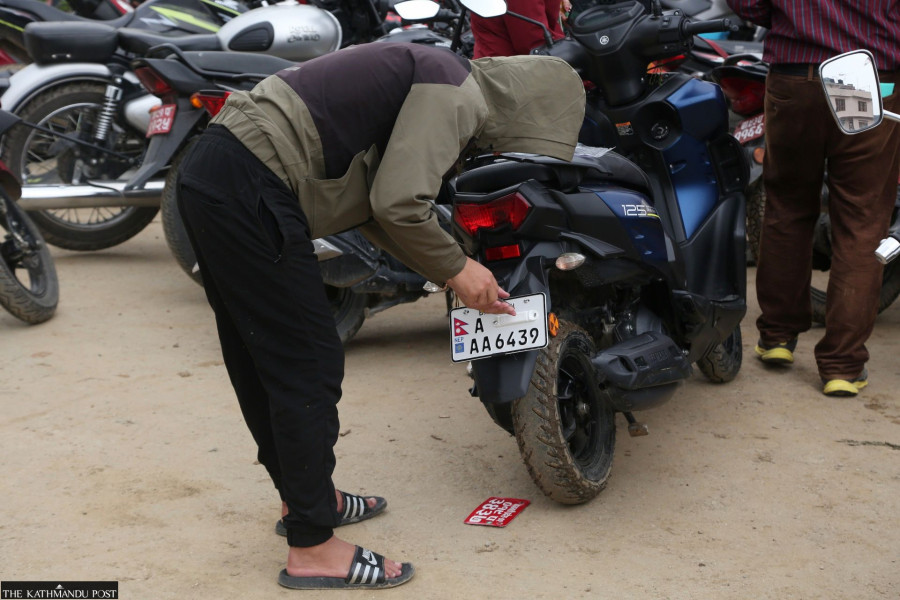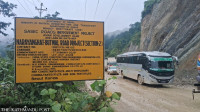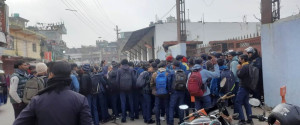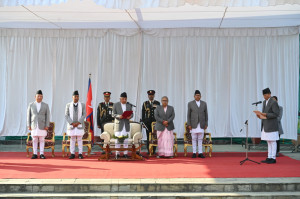National
Government pushes ahead with decision to enforce embossed number plates amid confusion
The decision has reignited public resistance over high costs, the use of English script instead of Devanagari, and inadequate technical preparedness.
Purushottam Poudel
The government has announced that all registered vehicles must carry embossed number plates from September 17, reviving a long-delayed plan first introduced in 2021.
Officials say that the system will digitise records, help improve traffic security, and align Nepal with global standards. But the decision has reignited public resistance over high costs, the use of English script instead of Devanagari, and inadequate technical preparedness.
The decision to enforce the embossed number plates was taken as per the decision of a thematic committee meeting held under the chairmanship of the Minister for Physical Infrastructure and Transportation Devendra Dahal on August 5.
The meeting attended by ministers and secretaries of the line ministries from all the seven provinces also decided to coordinate with the Ministry of Home Affairs to mobilise traffic police for enforcement.
From mid-September, transport offices across provinces will issue embossed number plates during vehicle registration, ownership transfer and renewal.
Officials say the system will help digitise records, strengthen monitoring and ensure more secure and tamper-proof plates.
Director General at the Department of Transport Management Rajeev Pokharel said that although the service will be available from September 17, there is no mandatory requirement to obtain it within a timeframe.
“It will be implemented gradually,” Pokharel said.
According to the government’s pricing structure, owners will have to pay Rs2,500 for motorcycles and scooters, Rs3,200 for cars, jeeps, vans and tractors, and Rs3,600 for heavy vehicles during installation of the embossed plate.
The embossed number plate project was initially rolled out in 2021, but full enforcement was stalled following public resistance and confusion.
But now the government plan to replace the current number plates with embossed ones on all vehicles has sparked controversy again. Like earlier, the debate has largely centred on the use of English language on the plates, their quality, and their high cost among others.
Transport expert Ashish Gajurel said that public opposition to the plan is natural since people are being asked to pay much more for number plates than they currently do. He added that the government has failed to clearly communicate the benefits of embossed number plates to the public, which has fuelled resistance. Gajurel also said that Devanagari script should be used on the plates.
“The current public resentment stems from the difficulties people face in obtaining embossed number plates,” said Gajurel, who is also executive director at the Nepal Intermodal Transport Development Committee. “If the government can ensure a convenient and hassle-free process for acquiring them, the protest is likely to diminish.”
According to the Department of Transport Management, Nepal is the only South Asian country yet to introduce embossed number plates. Globally, around 95 percent of countries have already adopted the system. One of the key points of controversy, however, is that the number plates are written in English.
Previously, the government had justified the use of English by citing the BBIN (Bangladesh, Bhutan, India, Nepal) agreement, arguing that uniformity was needed for cross-border transport which was a reason for adopting English plates instead of the Devanagari script, said Rup Narayan Bhattarai, former director general at the Department of Transport Management.
However, Bhutan has already withdrawn from the BBIN framework, and relations between Bangladesh and India have recently soured, raising further questions over the government’s rationale.
“If the government wishes, there is still room to use the Devanagari script on embossed number plates,” Bhattarai said.
An embossed number plate has camera-readable digits. It is also embedded with an RFID (radio-frequency identification) microchip.
Government officials claim that installing embossed number plates is also advantageous as the technology will help trace vehicles in cases of theft or disappearance or accident.
However, there are only two RFID-enabled gates in operation across the country to trace vehicles, leading to criticism that the government rushed to implement embossed number plates before completing the necessary technical preparations. Krishna Pant, an official overseeing the transport sector under the Ministry of Physical Infrastructure and Transport, acknowledges this criticism.
Pant said that while two such gates are ready for full operation and others are under construction, the government needs to accelerate these preparations.
Pant stated that since the contract period with the company responsible for producing embossed number plates is nearing its end, the government is determined to move ahead with implementation this time at any cost.
“Enforcing embossed number plates for everyone at once with a fixed deadline could create problems, but if implemented gradually, the process is less likely to face difficulties,” Pant said.
Meanwhile, the Federation of Nepalese National Transport Entrepreneurs, along with other transport operators, has criticised the government’s decision as ‘impractical’.
“Last year also, the government made a similar announcement, but that didn’t work. It’s not workable,” said Saroj Sitaula, the senior vice-chair of Transport Entrepreneurs. Our association has also expressed concerns about the language to be used on the embossed number system since many Nepalis are still not comfortable using English in their daily lives, Sitaula said.
Issuing a statement on Monday, the Federation’s General Secretary Deknath Gautam has called all the transport entrepreneurs to defy the government’s order to convert the number plates into embossed ones. He said this decision can be implemented only after the government ensures proper technology and logistical arrangements are in place and the people would not face unnecessary hassles for that.
The government’s plan to launch embossed number plates dates back a decade. The plan was included in the Three-Year Interim Plan 2007–2010, but it was put on the back burner due to a number of reasons like delays in conducting a proper study to roll out the project.
On May 30, 2016, the government tried to distribute embossed number plates to vehicles based on the provincial structure against the existing zonal format.
Later, on February 22, 2018, the Supreme Court issued an interim order to stop issuing embossed number plates. A single bench of then chief justice Gopal Prasad Parajuli issued the interim order in response to a petition filed by environmentalist Bharat Basnet.
Basnet had demanded that the Devanagari font be used on the number plates. He argued that the chip on the number plates could be used for spying and called it a breach of national security.
But on December 13, 2019, the Supreme Court vacated its stay order paving the way for the resumption of embossed number plate distribution.




 4.91°C Kathmandu
4.91°C Kathmandu







%20(1).jpg&w=300&height=200)






